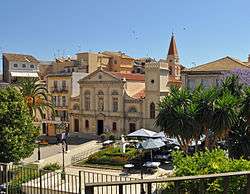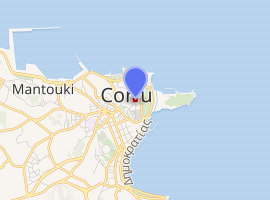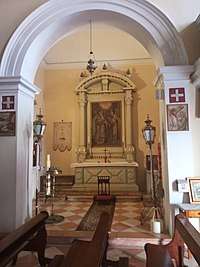Cathedral of Saint James and Saint Christopher
Cathedral of Saint Jacob and Saint Christopher is the seat of the Roman Catholic Archdiocese of Corfu, Zakynthos and Cephalonia.
| Cathedral of Saint Jacob and Saint Christopher | |
|---|---|
 Cathedral of Saint James and Saint Christopher, Corfu | |

| |
| Location | Corfu |
| Country | Greece |
| Administration | |
| Diocese | Roman Catholic Archdiocese of Corfu, Zakynthos and Cephalonia (since 1553) |
History of the building
The old cathedral was located in the Old Fortress of Corfu and was dedicated to the apostles Peter and Paul. This temple was one of the oldest monuments of the old fortress and was originally an Orthodox Cathedral which from the 13th to the 17th century was the cathedral of the city's Catholics. Originally the church was a basilica and beside it was a chapel dedicated to Saint Arsenius, first bishop of Corfu (876-952) who came from Bithynia of Judea. The temple was destroyed in 1718 by a fire caused by an explosion of gunpowder and the place was built a smaller temple whom was no longer belonging to the Catholic Diocese. The Greek Orthodox Church also built a small chapel inside the fortress dedicated to Saint Arsenius. Today there is no trace of these temples.[1]
Regarding the founding date of the new cathedral the information is not clear. In the place where today the church of the 15th century there was a ruined church and between 1431 and 1454 members of the brotherhood of the Saints James and Christopher asked permission from the then archbishop Martinus Bernardini to build there a guesthouse - a hospital for the needy, the sick and travelers members from brotherhood. The act of the Archdiocese was approved by papal bull on July 7, 1466 which required the fraternity to recruit priest and administrator at the same time offered the archbishop each year on February 2 liters a candle to commemorate the transfer of images of Saints James and Christopher on that day the church of St. Francis where they were in the new temple. In another version it was built only two chapels dedicated to Saint Jason and Sosipater. On December 31, 1533 the Latin Archbishop Jacobus Cocco consecrated the temple.[2]
During the second Turkish siege in 1571 the church suffered damages. The Historical Archive of Venice saved draft of the 1622 proposal showing extension of the building because it was too small for the needs of a cathedral. In 1658 it was renovated fundamentally from the Latin Archbishop Carclus Labia at his own expense. During his days Labia added as archbishop of Corfu the official celebration of Saint Spyridon's memory. After the reconstruction of this temple it was declared a Catholic Cathedral in August 1632. By order of the provveditore generale Philip Pasqualligo to the then Latin Bishop Benodictus Bragadinus (1620-1623) it was transferred to the Diocese bones of St. Arsenius and which remained until 1944 when he returned to the Orthodox Church.[3]
On October 23, 1709 the church was renovated again by the Latin Archbishop Augustinus Zacco (1706-1723) and was the center of Catholic worship rituals of the island. The last surgery before the war was done by Engineer Serpieri that in 1905 reformed outside the Temple.
On the night of September 13, 1943 after German bombing it was completely destroyed the exterior of the church.
Final form of the building

The final form of the building after the additional extensions is an aisled wooden roof basilica with three side chapels on each side (covered with monastic vaults and communicate with the main aisle with arched openings) and polygonal sanctuary particularly impressive size. Before repairing the temple seems that the main altar was once located deep in the Sanctuary and covered with ciborium reported as configured by parts, with architectural elements and sculptures from the Temple of the Annunciation. The total area of the Temple (Temple and aisles) than to 600 sq.m.
The access to the temple is from the west side close three doorways, a main central and two symmetrically arranged this. Inner side is shaped balcony narrow for the body (has been rebuilt from reinforced concrete). The floor of which rested before the destruction of the monument on four marble columns with paliotatous trunks coming in the publications or the Cathedral of the Old Fortress or from an ancient temple and which capitals were later 17th century. The roof of the main temple is situated at a height of 9.20 meters from the floor, around the base of the gable roof, which nests beams indicated in the plans of the stent, even specified that before the war was decorated with pictures of Christ, the Virgin Mary and the Apostles.[4]
The exterior of the church was reformed in the early 20th century. The central part of the face, which comprises three members, organized on rates (Tuscan pilasters) in two-storey layout and results in a triangular pediment. Curved blades are connecting the ends and lower parts of the central. The device reminds some example of Late Baroque churches of Venice which are based on the solution of the church of Iisy of Vignola. The face is accompanied by Tower Gothic morphology, while the bell steeple, a relatively small amount and with pyramidal ending, at the back next to the sanctuary.[5]
Chapels inside the church
- Chapel of Saint Spyridon and Saint Arsenic inside the church
- Chapel with the Byzantine icon of Our Lady of Health
- Chapel of St. Theresa of Lizzie
- Chapel of Saint Spyridon and Saint Arsenic
- Chapel of Immaculate Conception of Mary
- Chapel of Panachrantos Sacrament of the Eucharist
Sources
References
- [Afr.Agoropoulou- Mpirmpili: The Architecture of Corfu Latin Churches and position of the fabric of the city during the Venetian practical VII panioniou Lefkada Conference 26–30 May 2002 Volume II Athens 2004]
- [Dim.Chr.Kapadochou: Tribute to History of Corfu Athens 2001]
- [Afr.Agoropoulou- Mpirmpili: The Architecture of Corfu Latin Churches and position of the fabric of the city during the Venetian practical VII panioniou Lefkada Conference 26–30 May 2002 Volume II Athens 2004]
- [Sp.K.Papageorgiou: History Ekklisias of Kerkyras.Kerkyra 1920]
- [Afr.Agoropoulou- Mpirmpili: The Architecture of Corfu Latin Churches and position of the fabric of the city during the Venetian practical VII panioniou Lefkada Conference 26–30 May 2002 Volume II Athens 2004]